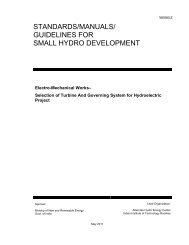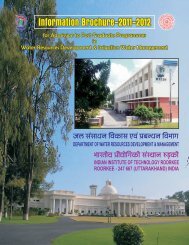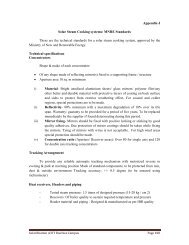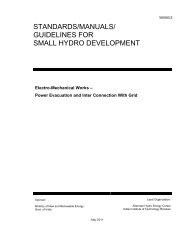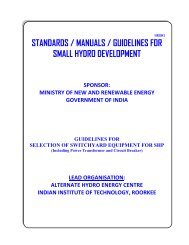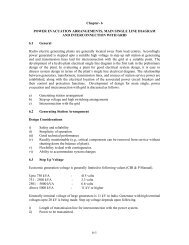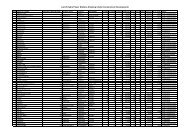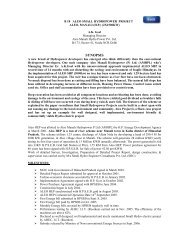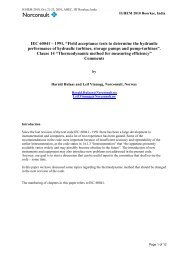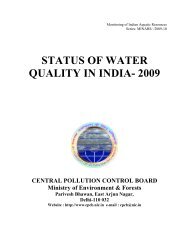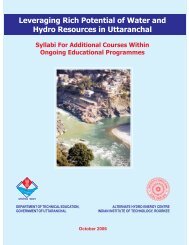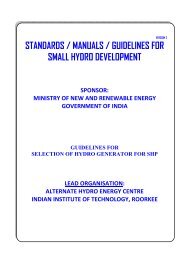annexures - Indian Institute of Technology Roorkee
annexures - Indian Institute of Technology Roorkee
annexures - Indian Institute of Technology Roorkee
You also want an ePaper? Increase the reach of your titles
YUMPU automatically turns print PDFs into web optimized ePapers that Google loves.
Guidelines for preparation <strong>of</strong> reports Under NRCP / NGRBALocation <strong>of</strong> existing facilities should be marked on the digitized map. Photographs showing thestatus <strong>of</strong> cleanliness and hygiene <strong>of</strong> CTCs should also be presented.7.3 SURVEY(i) Provision and location <strong>of</strong> new facilities must be supported by survey <strong>of</strong> target areas.(ii) Survey should be detailed or sample depending on the number and size <strong>of</strong> slums,unauthorised colonies and public places. If it is decided to conduct sample survey size <strong>of</strong>the sample should be decided. Normally, 15% <strong>of</strong> population should be enough(iii) Surveys should be structured to cover all the three categories viz. jhuggi-jhopri clusters,unauthorised colonies and public places.(iv) Current population living in target areas needing toilet facilities should be assessedrealistically. In respect <strong>of</strong> public places, data <strong>of</strong> floating population should be obtainedfrom local authorities and reported in the DPR. If not available, this data must begenerated through quick surveys.(v) Separate questionnaires should be developed for each category and circulated amongstprospective beneficiaries to elicit their views on the project. The data, among otherthings, should be generated on such aspects as whether the beneficiaries need suchfacility in their area and are ready to pay user charges.(vi) The questionnaire should specifically target female users to elicit their commitment touse the facility once available. This opportunity must be utilised to educate thebeneficiaries through questionnaire about the health hazards <strong>of</strong> open defecation and itsimpact on river pollution.(vii) The data generated from field investigations should be analysed and reported in the DPR.Keeping in view the existing facilities, if any, need for new projects should be establishedonly on the basis <strong>of</strong> the above data. According to existing norms, provision <strong>of</strong> one seat for50 users is taken for community toilets. The size <strong>of</strong> toilet blocks should be finalised on thisnorm.(viii) Surveys and stakeholders' consultations are specialised and time-consuming activitiesexpertise for which may not be available in-house with the implementing agency.(ix) There are a number <strong>of</strong> reputed NGOs, Community Based Organisations (CBOs) and socialorganisations, which are taking up such projects on turnkey basis including O&M. Suchagencies only would be suitable for conducting surveys and stakeholder's consultationsand thereafter preparing sustainable proposals and operating them on BOT basis.(x) Developing or promoting a CBO from the target area itself for this purpose should bepreferred, as these organisations would have the sense <strong>of</strong> ownership <strong>of</strong> the project. Theirestablishment cost would also be comparatively lower than others. (Please see boxbelow).(xi) Depending on its actual needs, it would be advisable for the implementing agency toappoint such agency(s) to implement the CTC projects and to make them sustainable.Complete details <strong>of</strong> the organisation selected for implementing the project with theirpast experience should be presented in the DPR.(xii) Present arrangement <strong>of</strong> water supply to target areas, quantity supplied per person perday and source <strong>of</strong> water supply should be provided in the DPR and indicated on maps.This information is necessary for designing toilet facilities.59



